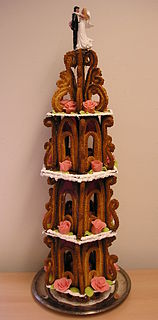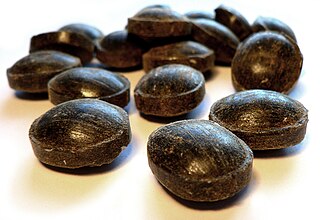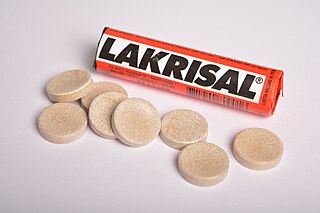
Guar gum, also called guaran, is a galactomannan polysaccharide extracted from guar beans that has thickening and stabilizing properties useful in the food, feed and industrial applications. The guar seeds are mechanically dehusked, hydrated, milled and screened according to application. It is typically produced as a free-flowing, off-white powder.

Confectionery is the art of making confections, which are food items that are rich in sugar and carbohydrates. Exact definitions are difficult. In general, though, confectionery is divided into two broad and somewhat overlapping categories, bakers' confections and sugar confections.

Tyrkisk peber is a salty liquorice candy flavoured with ammonium chloride, Produced by the Finnish company Fazer and popular in Northern Europe. Tyrkisk peber was originally invented by Per Fjelsten in 1976 and was originally made by the Danish company Perelly, before the company was acquired by Fazer.
Gum karaya or gum sterculia, also known as Indian gum tragacanth, is a vegetable gum produced as an exudate by trees of the genus Sterculia. Chemically, gum karaya is an acid polysaccharide composed of the sugars galactose, rhamnose and galacturonic acid. It is used as a thickener and emulsifier in foods, as a laxative, and as a denture adhesive. It is also used to adulterate Gum tragacanth due to their similar physical characteristics. As a food additive it has E number E416.

Liquorice or licorice is a confection usually flavoured with the extract of the roots of the liquorice plant Glycyrrhiza glabra. A wide variety of liquorice sweets are produced around the world. In North America, black licorice is distinguished from similar confectionery varieties that are not flavoured with liquorice extract but commonly manufactured in the form of chewy ropes or tubes. So called "black licorice" is also a widespread flavour in other forms of confectionery such as jellybeans. In addition to these, various other liquorice-based sweets are sold in the United Kingdom, such as liquorice allsorts. Dutch and Nordic liquorice characteristically contains ammonium chloride instead of sodium chloride, prominently so in salty liquorice.
A binder or binding agent is any material or substance that holds or draws other materials together to form a cohesive whole mechanically, chemically, by adhesion or cohesion.

Lakrisal is a Malaco brand of salty liquorice sold in the Nordic countries and the Netherlands.

Natural gums are polysaccharides of natural origin, capable of causing a large increase in a solution’s viscosity, even at small concentrations. They are mostly botanical gums, found in the woody elements of plants or in seed coatings. They are used in the food industry as thickening agents, gelling agents, emulsifying agents, and stabilizers, and in other industries as adhesives, binding agents, crystal inhibitors, clarifying agents, encapsulating agents, flocculating agents, swelling agents, foam stabilizers, etc.
Alhandal was a term used in Arabian pharmacy for the purgative extract of colocynth, or Bitter Cucumber.
Aromaticum rosatum is a medicinal powder made of red roses, liquorice, aloeswood, yellowheart, cinnamon, cloves, mace, gum tragacanth, nutmegs, cardamoms, galangals, spikenard, ambergris, and musk mixed together. It was chiefly prescribed in cordial and cephalic boles and electuaries, to strengthen the stomach and head.
In pre-modern medicine, the term catagmatic generally referred to any treatment purported to heal bone fractures, by promoting the formation of a callus.
In pre-modern medicine, catholicon was a soft electuary, so called as being supposedly universal in its curative and prophylactic abilities ; or a purger of all humours.

Prunus cerasoides, called the wild Himalayan cherry and sour cherry, is a deciduous cherry tree found in East Asia, South Asia and Southeast Asia. It is of the family Rosaceae and the genus Prunus.

Scaphium affine is a tree species in the family Malvaceae, subfamily Sterculioideae. It is native to mainland Southeast Asia and no subspecies are listed in the Catalogue of Life.
Locust bean gum is a thickening agent and gelling agent used in food technology.

Panjiri/Panjeri is a staple from the Punjab region and Hyderabad of the Indian subcontinent. treated as a nutritional supplement. It is made from whole-wheat flour fried in sugar and ghee, heavily laced with dried fruits and herbal gums. It is usually eaten in the winters to ward off cold. Panjiri/Panjeri is normally given to nursing mothers. It is considered Hot Food to help with the production of breast milk. It has been used for thousands of years, by the ancient Hindus then many centuries laters by the Sikhs. Its use is quite ritualistic and meaningful during nursing of mother.

Granulation is a jewellery manufacturing technique whereby a surface is covered in spherules or granules of precious metal. The technique is thought to have its origins in Sumer about 5,000 years ago. In the first millennium B.C. the technique was used by Etruscans living in present-day Italy. Greek craftsmen also employed the technique, but it was the work coming from Etruria which became famous, in part due to the mysteries surrounding the process.

Husk in botany is the outer shell or coating of a seed. It often refers to the leafy outer covering of an ear of maize (corn) as it grows on the plant. Literally, a husk or hull includes the protective outer covering of a seed, fruit, or vegetable. It can also refer to the exuvia of bugs or small animals left behind after moulting.













